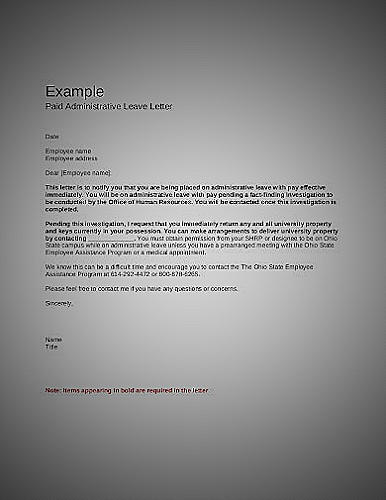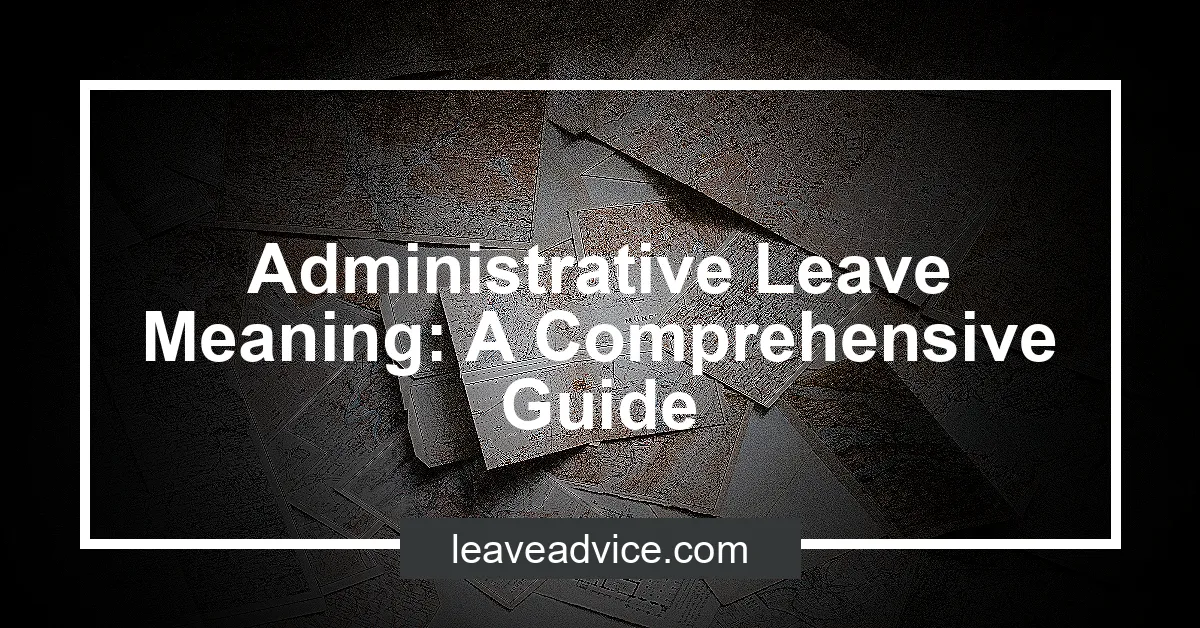Administrative Leave Meaning: A Comprehensive Guide
Administrative leave, also known as home assignment, is a temporary leave granted to an employee where their normal job responsibilities are temporarily relieved. The employee is usually asked to step away from their duties while an investigation takes place, or to allow for the employer to make a decision regarding their employment status.
Understanding what administrative leave meaning is important for both employees and employers to ensure that proper protocol is followed and employees’ rights are protected.
Are you curious about what administrative leave means? Check out this Youtube video that explains everything you need to know about it!
Gain important insight into employment issues and leave management by watching this informative video titled “Administrative leave Meaning – YouTube”. Don’t miss out!
What is Administrative Leave?
Administrative leave, also known as home assignment, is a temporary measure that is used to relieve an employee of their regular job duties. During this period, the employee is asked to stay at home during their regular work hours but still receive their regular pay and benefits.
This is a common practice in many organizations and can serve a variety of purposes, including investigations, disciplinary actions, safety concerns, and more.
Examples of Situations
There are various situations in which an employee may be placed on administrative leave. One common example is during an investigation, such as when there are allegations of misconduct or other types of wrongdoing.
In this case, placing the employee on administrative leave can help to prevent interference in the investigation and maintain the integrity of the process.
Another example is when there are pending disciplinary actions against an employee. Placing them on administrative leave can give the organization time to conduct a thorough investigation and determine the appropriate course of action.
In some cases, safety concerns can also lead to an employee being placed on administrative leave. For instance, if an employee is exhibiting erratic behavior or poses a risk to others in the workplace, they may be placed on administrative leave while the situation is assessed and addressed.
Other situations that may lead to administrative leave include medical conditions that prevent an employee from performing their job duties, compliance with legal requirements, or other unforeseen circumstances that require the employee to be temporarily relieved of their duties.
How to Request Administrative Leave
Administrative leave allows employees to take time off from work without using vacation or sick days. If you need to request administrative leave, follow these necessary steps:
Step 1: Contact Your Supervisor
Reach out to your supervisor to discuss the reasons why you need to take administrative leave. They will provide you with the necessary guidance and paperwork to get started.
Step 2: Fill Out the Required Forms
Documentation is necessary to request administrative leave. You may be asked to provide medical notes, court orders, or other paperwork.
Make sure to submit all the required documents to your supervisor.
Step 3: Wait for Approval
After you submit the necessary paperwork, you will wait for approval from your supervisor or HR department. Once your request is approved, you will receive notification of the start and end date of your administrative leave.
Step 4: Stay Connected
While on administrative leave, make sure to keep in touch with your supervisor to stay up-to-date on any assignments or projects. Also, contact HR about any questions or concerns you may have regarding your administrative leave.
Required Documentation
As mentioned earlier, the required documentation for administrative leave may vary depending on the reason for the request. If you need to take administrative leave due to a medical condition, your supervisor will likely require a doctor’s note.
Other types of documentation might include court orders, police reports, or bereavement notices.
Understanding Pay and Benefits During Administrative Leave
Administrative leave, also known as home assignment, is a temporary relief of an employee’s normal job responsibilities. During this period, the employee is asked to remain at home during regular work hours but continues to receive regular pay and benefits.
It is important to note that administrative leave can be paid or unpaid, depending on the employer’s decision. In most cases, employers allow their employees to keep their pay and benefits, like health insurance, during this absence.
If the administrative leave is unpaid, the employee may be eligible for unemployment benefits depending on the state’s laws. It is recommended for employees to review their state’s regulations or seek legal advice in case of a dispute.
What Employers Need to Know
Administrative leave is a temporary leave of absence from an employee’s job responsibilities. Employers may use this type of leave for various reasons including investigations, disciplinary actions, or other factors that may disrupt an employee’s ability to handle their job responsibilities.
As an employer, it is important to understand your responsibilities and obligations to your employees when placing them on administrative leave.
Legal Requirements
Employers have legal requirements they must follow when placing an employee on administrative leave. These requirements vary depending on the reason for the leave and the state where the employee works.
Some states require written notice to the employee, while others do not have specific statutory requirements. It is important to review all legal requirements in your state as failure to adhere to these requirements can result in legal consequences.
In general, employers are required to continue paying the employee’s regular pay and benefits during the period of administrative leave. This can include health insurance, vacation and sick pay, and retirement benefits.
However, employers may be required to report administrative leave as unpaid leave for tax purposes, so it’s important to consult with a tax professional to ensure compliance with all legal requirements.
Responsibilities to Employees
When placing an employee on administrative leave, it is important to maintain open and transparent communication with the employee. Employers should explain the reason for the leave, the expected duration of the leave, and the employee’s rights during this period.
It is also important to follow up with the employee regularly to keep them informed of any updates or changes regarding their leave status.
Employers should also be aware of any potential emotional or mental health impacts this type of leave can have on their employees. It is important to offer support and resources to employees during this stressful time, including counseling services and other forms of support as needed.

Conclusion
Administrative leave allows an employee to be temporarily relieved of their normal job responsibilities, while still receiving regular pay and benefits. It is up to the employer to decide if the employee can keep their pay and benefits during this absence.
It’s important for both employees and employers to understand the concept of administrative leave, its purpose, and its implications. Employers should have clear policies and procedures in place for employees to follow, and employees should familiarize themselves with these policies to ensure they know what to do in case they are ever placed on administrative leave.

